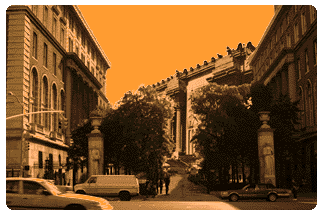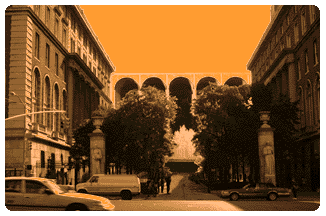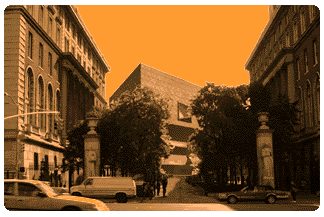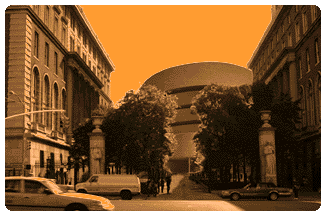Robert Fitzpatrick
Columbia is not necessarily a model when it comes to the arts. Witness our 243-year history.
Among the faculty recruited in the early years of Columbia College was Mozart's  librettist Lorenzo da Ponte. Unfortunately, da Ponte was hired in 1825 to teach Italian, not music;
during the university's first 150 years, the arts were scarcely represented. Only when Edward
McDowell joined the faculty 100 years ago and created the Department of Music did
Columbia begin its tentative and ambivalent involvement with the arts.
librettist Lorenzo da Ponte. Unfortunately, da Ponte was hired in 1825 to teach Italian, not music;
during the university's first 150 years, the arts were scarcely represented. Only when Edward
McDowell joined the faculty 100 years ago and created the Department of Music did
Columbia begin its tentative and ambivalent involvement with the arts.
Such
ambivalence was not limited to Columbia; it was typical of many of the great research
universities that grew up on the German model, where the practice of art -- making things --
was relegated to the Hochschule der Kunst and Hochschule für
Musik. The word "arts" in Arts and Sciences is a reference not to art-making (painting,
poetry, playwrighting), but to the liberal arts of languages, history, and philosophy: academic
disciplines that provide information of general cultural concern, as opposed to practical
training for a vocation or profession. Studying about the fine arts was considered appropriate;
studying how to, or doing them, was perceived as weakening the intellectual rigor of
academe.
Certain arts (music and creative writing) find it easier to survive than
others such as painting, film, dance, and theater. For film and video, there is a fear of popular
culture (entertainment!) and a belief that ephemeral moving images are less substantive than
written texts that have survived for centuries. For the other arts, it is their physicality that
disturbs: the body as instrument or tool and, at times, as subject matter.
In the last
30 years, Columbia has distinguished itself by twice abolishing theater, terminating such
faculty as Joe
Papp, and tearing down the Brander Matthews  Theater; twice abolishing painting and
sculpture, giving up a tradition of faculty such as Robert
Motherwell; shunting arts administration over to Teachers College; and allowing music composition
to secede from the School of the Arts for
the budgetary security of the music department in Arts and Sciences.
Theater; twice abolishing painting and
sculpture, giving up a tradition of faculty such as Robert
Motherwell; shunting arts administration over to Teachers College; and allowing music composition
to secede from the School of the Arts for
the budgetary security of the music department in Arts and Sciences.
There are
many possible explanations why the arts have not thrived at Columbia. Many distinguished
artists -- ideal master teachers -- are not themselves graduates of the academy. The artist's
focus is not on scholarship or research, but creation. The terminal degree is an M.F.A., not a
Ph.D., and the final thesis is not a dissertation but a novel, film, play, group of photographs,
or musical composition. The arts are messy, threatening, and personal; the subject matter is
frequently the self, the status quo is constantly questioned, and boundaries are rarely
respected. The arts are urban, inextricably linked to the city -- yet the McKim, Mead and White design of
the campus walls off the city and has historically discouraged links to the immediate
neighborhood and the larger urban campus.
Still, the arts thrive best in cities, and
no city has nourished them in the last 50 years as much as New York has. It is perhaps the
only city in the world today where conservation of the culture of the past and creation for the
future coexist in a healthy present. If Columbia is finally committing substantial resources to
strengthening the arts,  it is not a coincidence that it is finally proud to be an urban university
and has embraced New York as one of its most significant classrooms.
it is not a coincidence that it is finally proud to be an urban university
and has embraced New York as one of its most significant classrooms.
Thirty years
of neglect, we have reason to hope, are coming to an end. Dodge Hall has undergone a $10
million renovation. The Leroy
Neiman Center for Print Studies has been created, with exceptional facilities for
print-making and photography. The Digital Media Center has brought the School of the Arts
into readiness for the 21st century. A new initiative "Morningside to Manhattan" brings our
students into lively interaction with the city's cultural life, with a film festival at the former
Angelika 57, an art exhibition and readings at the Castelli Gallery, and new plays at
Raw Space.
More remains to be done. Pianos and practice rooms are far too few
and poorly maintained; theater rehearsal and performance spaces are the worst of any major
university in the country; some departments at Barnard and Columbia still fight turf wars
that do a disservice to undergraduates in the arts in both institutions.
The big
change is that Columbia is finally committed to making the arts a central part of
undergraduate education and to forging new links for its students with the
major cultural institutions of New York. The School of the Arts participates not only by
identifying and educating potential artists at the graduate level, but by giving an exposure to
art-making to many extremely gifted undergraduates who will go on to careers in law,
business, medicine, journalism, and government. Columbia's joint program with the
Juilliard School  allows musically and academically gifted students to study at both
institutions; no longer do multi-talented people have to make a painful either/or choice
between a conservatory education and the liberal arts.
allows musically and academically gifted students to study at both
institutions; no longer do multi-talented people have to make a painful either/or choice
between a conservatory education and the liberal arts.
Columbia's goal is not just
to teach certain techniques of art-making but to give intellectual understanding and insight
into what it means to be a creative human being, to make students comfortable with being
uncomfortable, to teach them to celebrate difference rather than being disturbed by it. In
short, the goal is to create intelligent, curious, and discerning audiences as well as interesting
artists. There is no better classroom for such an education than New York.
Related links...
Special issue on
the arts, Columbia magazine, Winter 1996
ROBERT FITZPATRICK is dean of Columbia's School of the Arts.
Photo Credits:
Street Photo: Photo: Jonathan Smith/Special Effects: Howard Roberts





 librettist Lorenzo da Ponte. Unfortunately, da Ponte was hired in 1825 to teach Italian, not music;
during the university's first 150 years, the arts were scarcely represented. Only when Edward
McDowell joined the faculty 100 years ago and created the Department of Music did
Columbia begin its tentative and ambivalent involvement with the arts.
librettist Lorenzo da Ponte. Unfortunately, da Ponte was hired in 1825 to teach Italian, not music;
during the university's first 150 years, the arts were scarcely represented. Only when Edward
McDowell joined the faculty 100 years ago and created the Department of Music did
Columbia begin its tentative and ambivalent involvement with the arts. Theater; twice abolishing painting and
sculpture, giving up a tradition of faculty such as Robert
Motherwell; shunting arts administration over to Teachers College; and allowing music composition
to secede from the School of the Arts for
the budgetary security of the music department in Arts and Sciences.
Theater; twice abolishing painting and
sculpture, giving up a tradition of faculty such as Robert
Motherwell; shunting arts administration over to Teachers College; and allowing music composition
to secede from the School of the Arts for
the budgetary security of the music department in Arts and Sciences. it is not a coincidence that it is finally proud to be an urban university
and has embraced New York as one of its most significant classrooms.
it is not a coincidence that it is finally proud to be an urban university
and has embraced New York as one of its most significant classrooms. allows musically and academically gifted students to study at both
institutions; no longer do multi-talented people have to make a painful either/or choice
between a conservatory education and the liberal arts.
allows musically and academically gifted students to study at both
institutions; no longer do multi-talented people have to make a painful either/or choice
between a conservatory education and the liberal arts.








